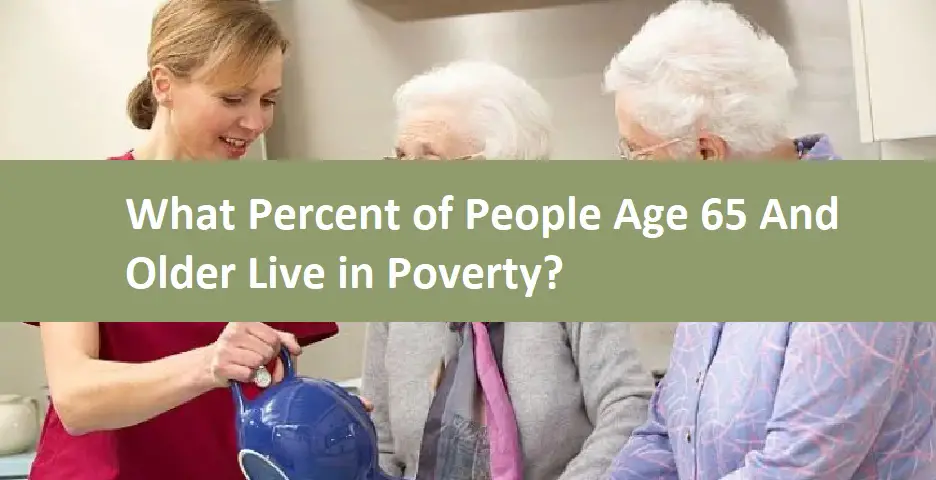In this article, we will explore the issue of poverty among older adults, including the current poverty rate among people aged 65 and older, the factors that contribute to poverty among seniors, and the consequences of poverty among older adults.
Keep reading to learn more!
What Percent of People Age 65 And Older Live in Poverty?
According to official government data, the poverty rate among people aged 65 and older in the United States was 8.9% in 2019. This is lower than the poverty rate among children and younger adults, but still, a significant issue that affects millions of older Americans.
The poverty threshold for this age group varies based on household size and composition, but for a single individual aged 65 or older, the poverty threshold was $12,760 in 2020. For a household with two individuals aged 65 or older, the poverty threshold was $17,240.
It’s worth noting that poverty rates among older adults vary by demographics. For example, in 2019, the poverty rate for women aged 65 and older was 10.7%, compared to 7.4% for men in the same age group.
Poverty rates also varied by race and ethnicity, with the highest rates among older Black and Hispanic adults. Additionally, poverty rates were higher among older adults who were not married or living with a partner.
These disparities are likely due to a variety of factors, including differences in income, access to healthcare and education, and historical discrimination. Understanding these disparities is critical to addressing poverty among older adults and promoting greater equity in our society.
Factors Contributing to Poverty Among Older Adults
There are a number of factors that can contribute to poverty among older adults. These include:
- Low Income: A primary factor contributing to poverty among older adults is low income, which can be caused by a range of issues, including insufficient retirement savings, limited access to employment, and low wages throughout their working years.
- Healthcare Costs: Healthcare expenses can be a major burden for older adults, especially those with chronic health conditions. Even with Medicare coverage, older adults often face high out-of-pocket costs for prescription drugs, long-term care, and other healthcare expenses.
- Housing Costs: Affordable housing can be difficult to find for many older adults, particularly those living on a fixed income. Housing costs can be especially burdensome for older adults living in urban areas, where the cost of living is often higher.
- Social Isolation: Older adults who are socially isolated are at greater risk of experiencing poverty. This is because social isolation can make it difficult to access services and support networks, and can lead to increased healthcare costs and other expenses.
- Racial and Ethnic Disparities: Older adults who are members of certain racial and ethnic groups, such as Black and Hispanic adults, are more likely to experience poverty. This is due to a range of factors including lower rates of homeownership, limited access to education and job opportunities, and systemic discrimination.
- Disability: Older adults with disabilities are at greater risk of poverty due to increased healthcare expenses, reduced earning potential, and limited access to employment opportunities.
- Age Discrimination: Some older adults face age discrimination in the workplace, which can make it difficult to find employment or to earn a living wage.
Addressing these factors is critical to reducing poverty among older adults and promoting greater economic security for all members of society.
Consequences of Poverty Among Older Adults
Poverty among older adults can have a range of negative consequences for both the individuals affected and society as a whole. Some of these consequences include:
- Poor Health Outcomes: Older adults living in poverty are more likely to experience chronic health conditions such as diabetes, heart disease, and arthritis. This is due to factors such as inadequate nutrition, limited access to healthcare, and increased stress.
- Social Isolation: Poverty can make it difficult for older adults to maintain social connections and engage in community activities, which can lead to increased feelings of loneliness and isolation.
- Financial Instability: Older adults living in poverty may struggle to afford basic necessities such as food, housing, and healthcare. This can lead to increased financial stress and the need to make difficult trade-offs between necessities.
- Increased Healthcare Costs: Older adults living in poverty may have limited access to preventative healthcare services, leading to more frequent hospitalizations and other costly medical interventions.
- The burden on Families: Poverty among older adults can place a significant burden on their families, who may have to provide financial and caregiving support to their loved ones.
- Increased Social Service Costs: As poverty among older adults increases, so does the demand for social services such as Medicare, Medicaid, and other assistance programs. This can place a strain on government resources and lead to increased costs for taxpayers.
Addressing poverty among older adults is critical not only to improve their individual well-being but also to promote a healthier, more stable, and more equitable society.
By investing in policies and programs that support older adults living in poverty, we can improve their quality of life and reduce the overall costs associated with poverty in our communities.
How to Decrease Poverty Among Seniors?
There are several ways to decrease poverty among seniors:
- Strengthen Social Security: Social Security is a critical safety net for millions of older adults, providing a reliable source of income in retirement. To reduce poverty among seniors, policymakers could strengthen Social Security by increasing benefits, improving the cost-of-living adjustment formula, and expanding eligibility to more workers.
- Increase Access to Affordable Healthcare: Healthcare expenses can be a significant burden for older adults living on a fixed income. Policies that increase access to affordable healthcare, including prescription drugs and long-term care, could help to reduce poverty among seniors.
- Expand Affordable Housing: Affordable housing can be difficult to find for many older adults, particularly those living on a fixed income. Policies that expand access to affordable housing, including rental assistance programs and supportive housing, could help to reduce housing costs and alleviate poverty among seniors.
- Improve Employment Opportunities: Many older adults continue to work well into their retirement years, either out of necessity or by choice. Policies that improve employment opportunities for older adults, such as job training programs and age discrimination protections, could help to reduce poverty among seniors.
- Provide Caregiving Support: Older adults who require caregiving support may be more likely to experience poverty due to the high cost of long-term care. Policies that provide caregiving support, such as paid family and medical leave and respite care, could help to reduce the financial burden of caregiving and alleviate poverty among seniors.
- Address Racial and Ethnic Disparities: Older adults who are members of certain racial and ethnic groups, such as Black and Hispanic adults, are more likely to experience poverty. Policies that address systemic racism and promote greater equity in our society could help to reduce poverty among seniors.
By implementing these policies and investing in programs that support older adults living in poverty, we can help to ensure that all seniors are able to enjoy a dignified, secure, and fulfilling retirement.
Find Out What Supermarkets Offer Senior Discounts
If you are a senior and want to reduce your expenses, you can visit stores that offer senior discounts. Here are some supermarkets that offer senior discounts:
| Safeway | Safeway offers a Senior Discount Day, where customers aged 55 and above can get 10% off their total purchase on the first Wednesday of each month. This discount is available at participating Safeway locations. |
| Fred Meyer | Fred Meyer offers a Senior Discount Day, where customers aged 55 and above can get 10% off their total purchase on the first Tuesday of each month. This discount is available at participating Fred Meyer locations. |
| Harris Teeter | Harris Teeter offers a senior discount on Thursdays, where customers aged 60 and above can get 5% off their total purchase. This discount is available at all Harris Teeter locations. |
It’s worth noting that senior discounts may vary by location and may not be available at all stores. It’s best to check with your local supermarket to see if they offer a senior discount and what the specific terms and conditions are.
Conclusion
In conclusion, poverty among older adults is a significant issue that can have negative consequences for both the individuals affected and society as a whole. Factors such as limited income, health issues, and inadequate social support can contribute to poverty among seniors.
To decrease poverty among seniors, policymakers can implement a range of policies and programs that support affordable healthcare, expand access to affordable housing, improve employment opportunities, and provide caregiving support.
By addressing poverty among seniors, we can help to ensure that all older adults are able to enjoy a dignified, secure, and fulfilling retirement.

Morgan Elfman is a compassionate writer, dedicated caregiver, and passionate advocate for senior well-being. Born and raised with a deep sense of empathy and a natural inclination towards service, Morgan has devoted her life to making a positive impact on the lives of seniors.
As a writer for www.choiceseniorlife.com, Morgan utilizes his skills to create insightful and informative content that addresses the unique needs and challenges faced by seniors and their families. Her articles not only provide valuable information on health, lifestyle, and care options but also strive to inspire and empower seniors to lead fulfilling lives.

